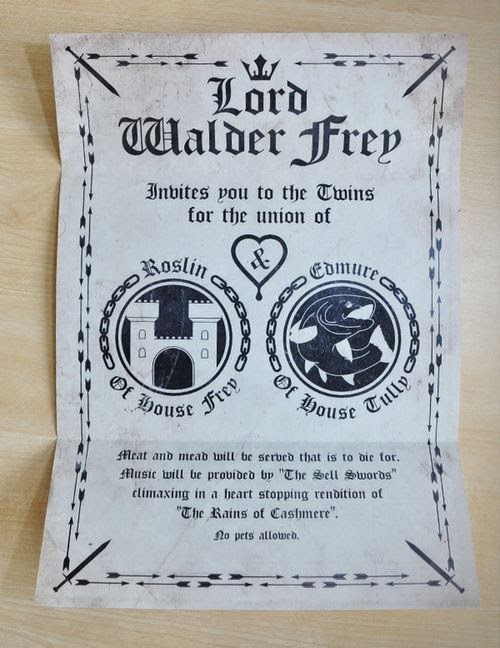
El año 2014 no tiene pinta de ser el año que vea la luz
Winds of Winter, pero los seguidores de
Canción de Hielo y Fuego podremos esperar el sexto volumen de la saga con algún otro material salido de la pluma de George R. R. Martin. Probablemente el que más expectación despierta es
The World of Ice and Fire, una especie de enciclopedia histórica de los Siete Reinos de Poniente de la que ya he hablado en alguna que otra ocasión en este blog. Según las últimas informaciones el libro saldrá a la venta en los EE. UU. este próximo otoño, muy posiblemente en el mes de octubre, y será fruto del trabajo del propio George Martin con los webmasters de Westeros.org (la página web más importante de Canción de Hielo y Fuego en inglés) Elio García y Linda Antonsson.
Durante el último año hemos tenido algún atisbo de
The World of Ice and Fire a través de lecturas realizadas por George Martin en diversas convenciones, pero esta misma mañana el escritor americano ha colgado un adelanto de la enciclopedia en su página web (
aquí). El texto es un fragmento de la historia de Aegon el Conquistador, el mismo que ya leyó hace un tiempo Martin en un acto con fans y que sirvió de base al resumen que hizo un asistente al acto y que compartí en el blog hace poco (
aquí). Ahora ya podemos leerlo completo en inglés, aunque solo es fragmento de una historia bastante mayor.
The maesters of the Citadel who keep the histories of Westeros have
used Aegon’s Conquest as their touchstone for the past three hundred
years. Birth, deaths, battles, and other events are dated either AC
(After the Conquest) or BC (Before the Conquest).
True scholars know that such dating is far from precise. Aegon
Targaryen’s conquest of the Seven Kingdoms did not take place in a
single day. More than two years passed between Aegon’s landing and his
Oldtown coronation . . . and even then the Conquest remained incomplete
since Dorne remained unsubdued. Sporadic attempts to bring the
Dornishmen into the realm continued all through King Aegon’s reign and
well into the reigns of his sons, making it impossible to fix a precise
end date for the Wars of Conquest.
Even the start date is a matter of some misconception. Many assume,
wrongly, that the reign of King Aegon I Targaryen began on the day he
landed at the mouth of the Blackwater Rush, beneath the three hills
where the city of King’s Landing eventually stood. Not so. The day of
Aegon’s Landing was celebrated by the king and his descendants, but the
Conqueror actually dated the start of his reign from the day he was
crowned and anointed in the Starry Sept of Oldtown by the High Septon of
the Faith. This coronation took place two years after Aegon’s Landing,
well after all three of the major battles of the Wars of Conquest had
been fought and won. Thus it can be seen that most of Aegon’s actual
conquering took place from 2-1 BC, Before the Conquest.
The Targaryens were of pure Valyrian blood, dragonlords of ancient
lineage. Twelve years before the Doom of Valyria (114 BC), Aenar
Targaryen sold his holdings in the Freehold and the Lands of the Long
Summer and moved with all his wives, wealth, slaves, dragons, siblings,
kin, and children to Dragonstone, a bleak island citadel beneath a
smoking mountain in the narrow sea.
At its apex Valyria was the greatest city in the known world, the
center of civilization. Within its shining walls, twoscore rival houses
vied for power and glory in court and council, rising and falling in an
endless, subtle, oft-savage struggle for dominance. The Targaryens were
far from the most powerful of the dragonlords, and their rivals saw
their flight to Dragonstone as an act of surrender, as cowardice. But
Lord Aenar’s maiden daughter Daenys, known forever afterward as Daenys
the Dreamer, had foreseen the destruction of Valyria by fire. And when
the Doom came twelve years later, the Targaryens were the only
dragonlords to survive.
Dragonstone had been the westernmost outpost of Valyrian power for
two centuries. Its location athwart the Gullet gave its lords a
stranglehold on Blackwater Bay, and enabled both the Targaryens and
their close allies, the Velaryons of Driftmark (a lesser house of
Valyrian descent) to fill their coffers off the passing trade. Velaryon
ships, along with those of another allied Valyrian house, the Celtigars
of Claw Isle, dominated the middle reaches of the narrow sea, whilst the
Targaryens ruled the skies with their dragons.
 El escritor Joe Abercrombie es de los que actualiza con bastante asiduidad su blog personal (aquí) para mantener bien informados a sus lectores sobre sus diversos progresos. Gracias a ello hemos podido saber que su próxima novela, Half a King, verá la luz en julio de este año en inglés, que la continuación Half the World está terminada y que ya ha empezado ha redactar la última parte de esta trilogía dirigida a un público más juvenil (Half a War).
El escritor Joe Abercrombie es de los que actualiza con bastante asiduidad su blog personal (aquí) para mantener bien informados a sus lectores sobre sus diversos progresos. Gracias a ello hemos podido saber que su próxima novela, Half a King, verá la luz en julio de este año en inglés, que la continuación Half the World está terminada y que ya ha empezado ha redactar la última parte de esta trilogía dirigida a un público más juvenil (Half a War).


















